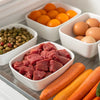Can I Feed My Dog Raw Food and Kibble? Exploring the Balance for a Healthy Diet
- Houndsy
Table of Contents
- Introduction
- Understanding Dog Nutrition: Kibble and Raw Food Explored
- The Science of Digestion: Mixing Raw and Kibble
- The Benefits of Mixing Raw and Kibble
- Safety Considerations: Avoiding Potential Pitfalls
- Practical Tips for a Successful Mixed Diet
- Conclusion
Introduction
As pet owners, we cherish our furry companions and want the very best for them, especially when it comes to their diet. In fact, a recent survey revealed that nearly 50% of pet parents are evaluating their dog’s health and nutrition more carefully than ever before. With a wealth of information available online, many of us find ourselves wondering: Can I feed my dog raw food and kibble together? This intriguing question not only prompts us to reflect on our feeding choices but also highlights the complexities of canine nutrition.
The mix of raw food and kibble is a topic filled with passionate opinions from various pet owners, veterinarians, and nutritionists. They see benefits and potential pitfalls. This blog post aims to demystify the practice of mixing raw food with kibble, offering insights into the nutritional balance, digestion, and safety considerations. By the end, you’ll feel empowered to make informed decisions about your dog’s meals, ensuring they receive the best possible nourishment to thrive.
Throughout this post, we will cover essential aspects such as the nutritional benefits of both raw and kibble diets, the potential digestive implications of mixing them, recommended feeding practices, and practical tips for a successful mixed feeding routine. Together, let's navigate this important topic and elevate our understanding of canine nutrition.
Understanding Dog Nutrition: Kibble and Raw Food Explored
To appreciate whether mixing raw food with kibble is a great approach, we first need to dive deeper into the characteristics of both feeding styles.
The Basics of Kibble
Kibble, or dry dog food, has long been a staple in the diets of our canine companions. Here are some fundamental points regarding kibble:
- Convenience: Kibble is easy to store, measure, and serve, making it a practical choice for busy pet owners.
- Cost-Effective: Generally, kibble is more affordable than raw food options, especially for those on a budget.
- Nutrition: High-quality kibbles are formulated to meet AAFCO (Association of American Feed Control Officials) standards, ensuring they are complete and balanced for a dog's dietary needs. However, many lower-quality kibbles contain fillers and excess carbohydrates that may not be optimal for every dog.
The Appeal of Raw Food
Conversely, feeding dogs a raw diet often garners enthusiasm from advocates who tout its many benefits, including:
- Nutritional Integrity: Raw food is packed with essential nutrients, enzymes, and vitamins that might be diminished in processed kibble.
- Health Benefits: Many pet parents report improvements in coat condition, energy levels, digestion, and overall vitality after switching to a raw food regimen.
- Variety: Raw diets often incorporate an array of protein sources, including meat, organs, bones, and vegetables, catering to a dog's instinctual feeding habits.
Comparative Nutritional Profiles
While kibble typically consists of 30%-60% carbohydrates, raw food generally contains 0%-15% carbohydrates. This stark contrast shows the foundational differences in their compositions, which play a crucial role in digestibility and nutritional value.
The Science of Digestion: Mixing Raw and Kibble
Understanding how dogs digest food is crucial in evaluating whether it’s safe to mix the two diets.
The Digestive Process
Within a dog's digestive system, numerous enzymes work hard to break down the food they consume—transforming it into essential nutrients and energy. Dogs possess a highly acidic stomach (pH around 1-2) that helps break down proteins and kill harmful bacteria. This environment allows them to digest raw foods effectively.
However, the introduction of kibble, which contains substantial carbohydrates, can alter this digestive setting:
- Starch increases the pH level, making it less acidic and potentially inhibiting protein digestion.
- A higher pH can result in an environment where pathogenic bacteria thrive, such as E. coli and Salmonella.
Therefore, when kibble is mixed with raw food, the digestive dynamics shift. It’s vital to recognize that while many dogs can manage mixed diets without issues, others may experience digestive upset, particularly with abrupt changes in their diet.
Transitioning between Diets
If you're considering introducing a mix of raw and kibble into your dog's diet, transitioning should be done gradually. A sudden dietary shift can lead to gastrointestinal distress. Here’s a straightforward plan:
- Begin by mixing a small amount of raw food into your dog’s kibble.
- Gradually increase the ratio of raw food over 4-6 days until you reach the desired balance (for example, a 50-50 ratio).
- Monitor your dog's response to the new diet. Digestive upset, such as diarrhea or vomiting, may indicate that your dog needs more time to adjust or that a different ratio might be healthier for them.
The Benefits of Mixing Raw and Kibble
While concerns exist about the safety of combining raw food and kibble, we cannot overlook the advantages that this mixed feeding approach can offer.
Nutritional Boost
Integrating raw food, even as a small portion of your dog’s meals, can yield significant health benefits. Just a 10-15% ratio of raw food in their diet can enhance overall well-being, potentially translating into:
- Improved coat health and sheen.
- Increased energy levels and better playfulness.
- Enhanced immunity and reduced allergies.
Cost-Effectiveness
For pet owners watching their budgets, completely switching to raw food can be cost-prohibitive. Mixing kibble with raw food enables pet owners to provide their dogs with the nutritional benefits of fresh food while maintaining a manageable budget. A 50-50 approach may halve costs compared to feeding exclusively raw, maintaining better nutrition without breaking the bank.
Flexibility in Feeding Routines
The logistical flexibility of mixing raw and kibble is appealing. Depending on one's schedule, raw food can be served when time permits, and kibble can provide a convenient option for busier days. This variability fits seamlessly into many households, especially those with diverse family dynamics and activities.
Safety Considerations: Avoiding Potential Pitfalls
While the practice of mixing raw food and kibble can be advantageous, it also necessitates careful consideration to mitigate potential risks.
Choose Quality Ingredients
Not all kibbles are created equal. Opt for high-quality brands that prioritize animal protein over fillers and by-products. Similarly, when selecting raw ingredients, source meats from reputable suppliers to decrease the risk of contamination.
Consider Your Dog’s Unique Needs
Every dog is unique, with varying sensitivities and dietary needs. For instance, certain breeds may be more prone to digestive issues. Conversely, some dogs thrive on a mixed feeding regimen without complications. Pay close attention to your dog’s reactions and adjust their diet accordingly.
Supplement with Probiotics
Introducing probiotics can help foster a healthy gut balance when mixing raw and kibble. Probiotics crowd out harmful bacteria and assist with digestion, facilitating transition and optimally processing their meals.
Monitor Portions Carefully
Keep in mind that because raw food is generally more nutrient-dense than kibble, larger portions of kibble may inadvertently lead to an imbalanced diet if you’re not careful. Aim to follow feeding guidelines provided by your vet or refer to resources tailored specifically for mixed feeding protocols.
Practical Tips for a Successful Mixed Diet
Now that we’ve explored the benefits and challenges of combining raw food and kibble, let’s dive into practical advice for implementing a successful mixed feeding routine.
Establish a Feeding Schedule
Creating a consistent feeding schedule can help streamline meal times for both you and your pet. This can also ease the transition to new dietary practices. Consider these options:
- Serve kibble in the morning for convenience and raw food in the evening when you have more preparation time.
- Rotating meals—mixing raw and kibble instead of serving them together—may alleviate any digestive anxiety your dog encounters.
Keep it Clean
Hygiene is essential when handling raw food. Wash your hands thoroughly after serving raw meat, sanitize feeding areas, and ensure any surfaces in contact with raw food are disinfected. This minimizes the risk of bacterial contamination spreading to humans or other pets in your household.
Consider Your Dog's Digestive Sensitivity
Every dog is different. If you have a dog with a sensitive stomach or a known history of gastrointestinal issues, it may be best to serve raw and kibble at different times rather than mixing them together. This creates two distinct meal experiences and lets your dog digest each type of food efficiently.
Conclusion
Navigating the world of pet nutrition can feel overwhelming, especially when we start considering different food types. However, mixing raw food with kibble offers a flexible and often nutritious option that can benefit many dogs when done thoughtfully. By understanding the science of digestion, the nutritional value of each food type, and practical tips for implementation, we can create balanced meals incorporating the best of both worlds.
So, are you ready to elevate your dog’s feeding experience? Together, we can simplify pet care and introduce wholesome nutrition through thoughtful feeding practices. Remember, any inclusion of fresh, raw food can always serve as a step towards improved canine health!
FAQ
1. Can I mix raw food and kibble in the same bowl?
Yes, many dogs can digest a mix of raw food and kibble in the same meal. However, consider your dog’s sensitivity and adjust as necessary.
2. What ratio of raw food to kibble is recommended?
There is no one-size-fits-all answer. A common ratio is 50% raw food to 50% kibble, but you might adjust this based on your dog’s specific needs and your budget.
3. How should I transition my dog to a mixed diet?
Introduce raw food gradually over 4-6 days to allow your dog’s digestive system to acclimate without causing upset.
4. Are there health risks associated with feeding raw meat?
While raw meat can carry bacteria, providing high-quality meat and following safe food handling practices reduces these risks significantly. Monitoring for signs of digestive upset can help you gauge your dog’s tolerance.
5. Should I consult my veterinarian?
Absolutely! Veterinary input is crucial to determining the best diet for your pet based on their individual health, nutritional needs, and lifestyle.
As you explore feeding options, don’t forget to check out the Houndsy Kibble Dispenser, our flagship product designed to elevate your dog feeding experience. Make feeding time practical and stylish! Order Now.













